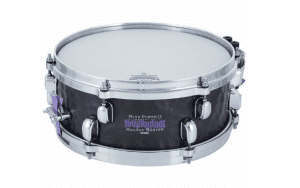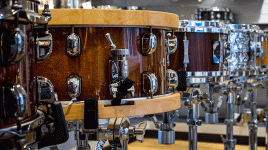
To many, getting the best possible sound out of their drums feels like a daunting task. It begins with choosing the right drumheads and doesn’t end with the question of the right tuning techniques. However, once you have a basic understanding of the physics behind your drum sound, things become a lot easier – and a lot of fun! Here are a few tips on drum tuning and choosing the right drumheads. We may even share a few drum hacks. 🥁✨
By the way, there are now many useful tools that can help you achieve your dream sound. Find out more in our detailed, free Drum Tuning Guide.
Snare Drum Tuning
The snare drum is known as the heart of the drum set and has a significant impact on the feel and sound of a song. To get a good snare sound, you should first tune the resonant head very high. In the area of the snare bed, which is the recess in the resonant head’s bearing edge, you should tighten it a bit more. This creates a defined bearing for the snare wires, which should be straight and centered. The batter head can be tuned to your preference, but ensure that it is evenly tightened and that the pitch is uniform across all tuning screws, otherwise, it will sound thin and unpleasant. Keep in mind that each snare drum reacts differently, so it pays off to find the “sweet spot” of your instrument by experimenting.
👉 Find all snare drums at Thomann!
Tom Tuning
Depending on the sound you envision, toms generally produce a somewhat longer tone than the snare drum. Coarse tuning mistakes thus result in whining overtones. Start again with the resonant head and think about whether you want the tom to sound high or low. It’s often easier to start higher because you can better hear and adjust the pitches on the head. Then proceed with the batter side.
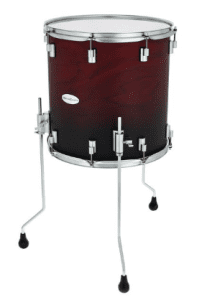
DrumCraft Series 6 16″x16″ Floor Tom SBR
A good method is cross-tuning, which means operating the tuning screws that are opposite each other. This lowers the hoop evenly, and your tone becomes cleaner and more predictable. Tip: Don’t be afraid of mistakes and boldly go for extremes. Tune quickly and also try tuning very high or very low. Both will give you a sense of what the drum can do and where it sounds best.
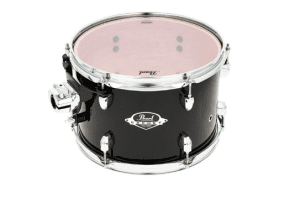
Pearl 12″x08″ Export Tom Tom #31
If you want the tone to drop slightly after striking, it is advisable to tune the resonant head a bit higher than the batter head. Tuning both heads to the same pitch, on the other hand, ensures a consistent decay. It is less common to tune the resonant head lower than the batter head, as a rising tone after striking is generally not desired.
👉 Check out all toms on thomann.de!
Which Heads Suit Your Sound Idea?
Besides tuning, the type of head used plays a significant role. The thicker it is, the drier it will sound. The high frequencies of often annoying overtones are slowed down by more mass. This applies to your toms as well.
Single-ply Snare and Tom Heads
An absolute all-rounder is the single-ply, white-coated head. It is easy to tune and can be modified in many different directions through damping.
- suitable for all styles
- open, overtone-rich sound
- medium durability
Double-ply Snare Heads
and those with a central reinforcement spot (“Dot”) offer increased durability and sound somewhat more controlled.
- more compact tone
- reduced overtones
- higher durability than single-ply standard models
Heads with Dampening Ring
If you prefer a distinctly drier approach, consider models with an integrated dampening ring.
- drier, overtone-poor sound
- very recording-friendly, further damping measures are often not necessary
- somewhat more challenging to tune, as the overtones are harder to hear
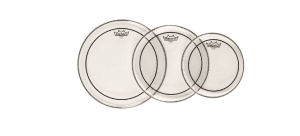
Tom head with Dampening Ring Remo PP-0922-PS Pinstripe Clear
Low Effort, High Impact – Damping
A precisely tuned, naturally resonating drum has its own charm and fits well into many musical situations. However, if you need a quick or drastic adjustment to your snare or tom sound, dampeners are the way to go. Depending on the model, you can simply lay them on the head or attach them to the rim. Tools are usually not necessary.
Classic Damping, Easy to Apply
All soft materials that dampen the head vibration create a damping effect. Classics include Gaffa tape, simple dampening rings, and Moongels. Small elements made of leather or faux fur are also very popular.
More Style for Authentic Retro Sound
The tablecloth has long been the best friend of vintage drum sound enthusiasts. It goes very dry, compact, and low on overtones. If you like it stylish, here are a few recommendations.
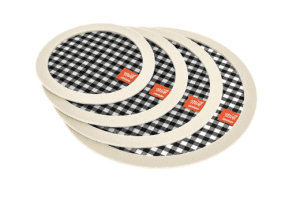
Rohema Mr. Muff Muffins Set
Bass Drum Tuning – Short and Punchy or Open and Round?
The most popular bass drum sound can be described as punchy, powerful, and defined. It’s prevalent in many styles from metal to hip-hop because it perfectly complements the bass. Fortunately, it’s quite straightforward to achieve. For this, initially loosen your batter head until it shows wrinkles. Then, tighten the tuning screws across from each other slowly until they catch.
Did you know that the right drumheads can significantly ease the task of achieving your desired sound, especially on the bass drum? Pre-dampened models like the Remo Powerstroke, Aquarian Super Kick, or Evans EQ4 have built-in dampening rings that remove unwanted mid-tones and enhance a fat sound. If that’s not enough, you can also use a separate dampening pad.
The choice of beater is also crucial to achieving your desired sound. The harder the striking surface, the more defined and focused will be the attack of your bass drum. Have you ever tried a beater made of wood or leather? Or one made of soft fleece? Switching the beater can save you a lot of time in the studio and bring about impressive changes in sound quickly.
👉 Explore all bass drums in the Thomann Shop!
Drum Tuning is a Process – So Just Get Started!
To quickly feel confident when tuning your drums, just do it regularly. This not only trains you technically but also shapes your taste. Having various types of heads available can lead to real revelations. Your ears are your most important tool by far. Professionals rarely tune according to “correct” procedures. They tune until the drum sounds as they like it. You should do the same!
You are currently viewing a placeholder content from YouTube. To access the actual content, click the button below. Please note that doing so will share data with third-party providers.
You are currently viewing a placeholder content from YouTube. To access the actual content, click the button below. Please note that doing so will share data with third-party providers.
You are currently viewing a placeholder content from YouTube. To access the actual content, click the button below. Please note that doing so will share data with third-party providers.
Drum Tuning | Your Feedback
What are your experiences with drum tuning? Do you have any tips you’d like to share? Let us know in a comment!!
You are currently viewing a placeholder content from Facebook. To access the actual content, click the button below. Please note that doing so will share data with third-party providers.
More InformationYou are currently viewing a placeholder content from Instagram. To access the actual content, click the button below. Please note that doing so will share data with third-party providers.
More InformationYou are currently viewing a placeholder content from X. To access the actual content, click the button below. Please note that doing so will share data with third-party providers.
More Information